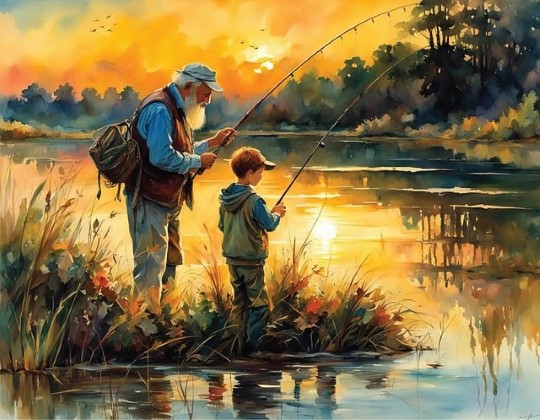Fishing art is a beautiful fusion of creativity and nature, spotlighting the passion for angling alongside artistic expression. Whether it’s the serenity of a fisherman on a quiet lake or the intricate textures of a fish’s scales, fishing art has captured the imagination of artists and fishing enthusiasts alike.
This blog explores the growing appeal of fishing art, its rich history, and how it continues to impact communities. We’ll also guide you on how to begin creating your own fishing-inspired artwork. Let’s celebrate the world where art and fishing beautifully collide!
Table of Contents
The Intersection of Art and Fishing

Fishing has been an inspiring subject for artists across generations. From ancient cave paintings depicting fish to modern-day galleries showcasing avant-garde fishing artwork, the connection between fishing and art is undeniable.
A Brief History
Fishing-themed art dates back thousands of years. Ancient civilizations, such as the Egyptians and Native Americans, used fish as symbols in their murals and pottery, representing sustenance and spirituality. Centuries later, artists from the Romantic and Impressionist movements created timeless pieces, such as Winslow Homer’s captivating fishing scenes drenched in natural light and tranquility.
Modern interpretations have broken traditional boundaries, with abstract renditions and conceptual pieces capturing the essence of fishing. Whether nostalgic or contemporary, fishing art continues to evolve while remaining deeply rooted in its universal appeal.
Also Read: How Animal Art Inspires Conservation and Creativity
Types of Fishing Art
Fishing art encompasses a range of mediums, each with its unique charm. Here’s an overview of some popular types, paired with standout examples.
Paintings
Fishing paintings have long been a favorite among art enthusiasts. From oil paintings showcasing breathtaking seascapes to vibrant watercolor interpretations, there’s no shortage of awe-inspiring works.
Example: Winslow Homer’s The Gulf Stream masterfully blends fishing and survival into an emotionally gripping piece.
Sculptures
Fishing sculptures, often crafted from wood, bronze, or even driftwood, bring dimension and texture to this timeless theme. These works can depict anything from fishermen in action to life-like sculptures of specific fish species.
Example: The Smithsonian’s fishing sculpture collection showcases elaborate forms honoring fishing traditions.
Photography
Photography captures the raw, unfiltered beauty of fishing moments. From a reflective fisher at sunset to a perfectly timed leap of a trout, it provides an authentic glimpse into the emotion behind the craft.
Example: Renowned outdoor photographers like Thomas Mangelsen have immortalized iconic fishing moments in their work.
Literature
Fishing art isn’t limited to images alone. Literature—both classic and contemporary—has brought to life the many tales surrounding fishing. From reflective essays to thrilling fiction, words have a way of enhancing the artistry in angling.
Example: A River Runs Through It by Norman Maclean is a poetic novel that beautifully ties fly-fishing into themes of life and family.
Also Read: Yarn Art for Beginners: Tips, Trends, and Creative Inspiration
The Impact of Fishing Art on Communities

Fishing art not only inspires individuals, but also profoundly impacts local communities.
Boosting Local Economies
Towns near lakes, rivers, or coastal areas often witness an economic boost thanks to fishing art. Galleries, art fairs, and exhibitions attract tourists and collectors alike. Art sales not only support local artists but also promote the fishing culture of the region, enticing anglers from around the globe.
Building Community Bonds
Fishing art has incredible power to unite people. Art exhibitions, public murals, and workshops bring fishing enthusiasts and art lovers together, fostering a sense of community. Events like fishing festivals often align with art celebrations, promoting collaboration between different creative and outdoor groups.
Inspiring Future Generations
Many accomplished artists and hobbyists host workshops or become mentors, teaching younger generations not only about fishing as a lifestyle but as a creative outlet. Such initiatives ensure that the rich cultural bridge between fishing and art is carried forward for years to come.
Creating Your Own Fishing Art

Whether you’re an experienced artist or a curious beginner, the beauty of fishing art lies in its accessibility. Anyone with a passion for fishing and an eye for creativity can craft something extraordinary.
Find Inspiration
Start by seeking inspiration in your surroundings. Observe the ripples of water on a lake, the motion of fish, or the intricate designs of fishing gear. Spend time outdoors—it’s an endless reservoir of creative energy!
Choose Your Medium
Your medium plays a crucial role in shaping your artistic output. Do you want realistic detail, or would you prefer a more abstract interpretation?
- Paint: Perfect for traditionalists drawn to soft or bold color palettes.
- Woodworking/Metalwork: Ideal for kinetic sculptures or rustic wall hangings.
- Photography: Great for capturing raw, natural beauty while experimenting with light and angles.
Share Your Work
Once you’ve created your masterpiece, don’t keep it to yourself! Share your art on platforms like Instagram or in local art exhibits. Many communities, both online and offline, welcome and celebrate fishing art. You never know how far your work might inspire others!
Why Fishing Art Matters
Fishing art is far more than just beautiful visuals. It’s a medium that narrates stories, preserves traditions, and builds connections. By pairing creativity with outdoor passion, it allows individuals and communities to reflect on and celebrate the timeless charm of fishing.
If you’re new to fishing art, don’t hesitate! Start exploring different mediums or join groups that foster learning and creativity. Attend exhibitions and share your own works or findings with fellow enthusiasts. The more we engage, the richer this vibrant world of fishing art becomes.
Want to discover more? Visit your local gallery or museum, or subscribe to online fishing and art communities. There’s always another masterpiece waiting to be found—or created.



Pingback: How to Start Your Own Beach Art Today
Pingback: Things We Never Got Over in Pop Culture